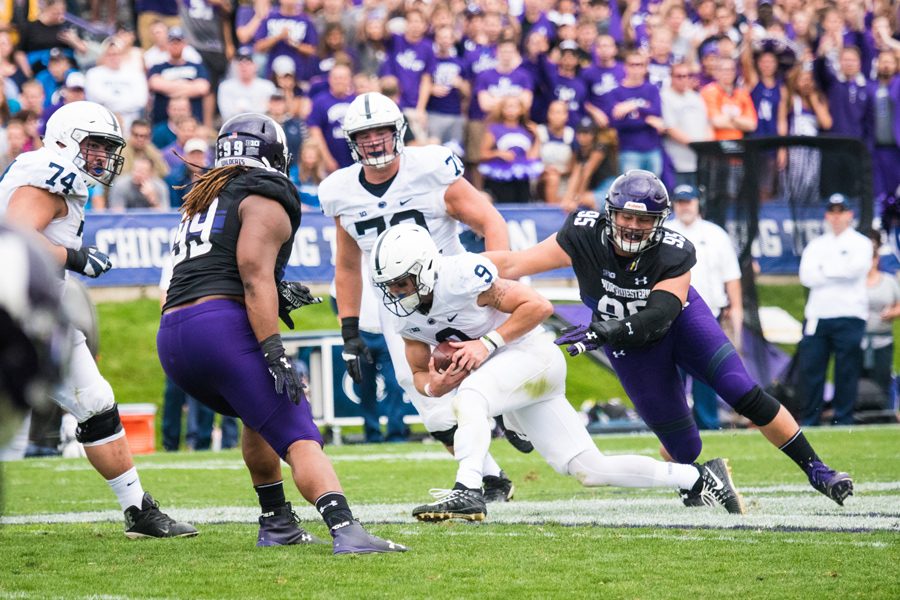Football: Wildcats hope RPO familiarity proves advantageous against Maryland
(Daily file photo by Daniel Tian)
Sophomore defensive lineman Alex Miller wraps up Penn State quarterback Trace McSorley. The Wildcats will look to stop maryland’s run-pass option Saturday.
October 12, 2017
Football
Run-pass options are the latest rage in college football. No team knows that better than Northwestern.
Four of the Wildcats’ five opponents to date have employed “RPOs” heavily, and this coming Saturday, Maryland will make that five of six. By now, NU’s defense has an idea of what’s coming — it’s just a matter of stopping it.
Last week, the Cats did. In fact, their RPO-defending system surpassed all expectations against Penn State’s Saquon Barkley, holding the Heisman candidate to fewer than 1.5 yards per carry outside of one explosive play.
This week, NU faces a new challenge: containing Maryland running back Ty Johnson, whose 8.1 yards-per-carry average leads the conference.
In a road win over Minnesota two weeks ago, the Terrapins heavily showcased their RPO system, which gives their quarterback the choice to hand the ball off to Johnson, run or pass to a wide receiver on a screen.
His decision largely depends on a split-second glance at a targeted linebacker at the time of the potential handoff, much like a read-option play. Adding in the third option of a quick pass, however, forces the quarterback to read more than just one linebacker — but also makes the play trickier to defend.
“They’re actually reading … the guys at the second level, and if you bring safeties into the fit, they’re reading the safeties,” coach Pat Fitzgerald said. “If the quarterback is going to show the ball like it’s going to be a run play and you’re getting full run action from the O-line, it’s hard to go defeat the run and then get vertical (if it becomes a pass play). It’s a challenge, no doubt — that’s why it’s so in vogue.”
Which quarterback will make those reads for Maryland come Saturday is a mystery. The Terrapins’ first- and second-string quarterbacks have suffered season-ending injuries, and third-stringer Max Bortenschlager is reportedly a game-time decision. It’s possible the Cats could be facing fourth-stringer Caleb Henderson, who has two career pass attempts.
Given Maryland’s quarterback situation, senior safety Kyle Queiro said NU will focus first on stopping Johnson and fellow running back Lorenzo Harrison.
“With the way our D-line is playing, we will probably bottle that up early, and hopefully (that will) get them to get away from that rushing attack and … try to press us through the air,” Queiro said.
Queiro’s confidence isn’t misplaced. After allowing 375 rushing yards and tallying just one sack in the first two games, sophomore end Joe Gaziano said the defensive line was called out by the coaching staff. The line responded by recording 10 sacks and allowing only 300 rushing yards over the last three games combined.
In NU’s defensive system, players are pre-designated as either “run primary, pass secondary” or “pass primary, run secondary” for any given play so they aren’t tasked with making decisions based off the opposing offense’s misdirection plays, Queiro said.
“(The defensive line’s) main priority is to stop the run,” Gaziano said, “So we’ve got to … control our gaps, control the blockers and then let the linebackers flow off of us (while) reading the quarterback, whether it is a pass or a run.”
The Cats might be able to learn from Ohio State’s success against Maryland last week. By sliding safeties closer to the box and getting a heavy rush off the edges, the Buckeyes forced the inexperienced Bortenschlager to choose the pass option more than he planned, and it paid off: He looked jittery and went 3-for-12 for 16 yards.
NU’s defense doesn’t boast quite the athleticism of Ohio State’s — but it does have a system, refined by four Saturdays of facing RPO offenses already, that it believes can stop the Terrapins’ attack.
“We’ve been working on getting our (line) rushes to be more effective in practice, and I think we’ve translated that well into the games,” Gaziano said. “There’s still things to improve on, but I think we’re trending in the right direction.”
Email: [email protected]
Twitter: @benpope111


